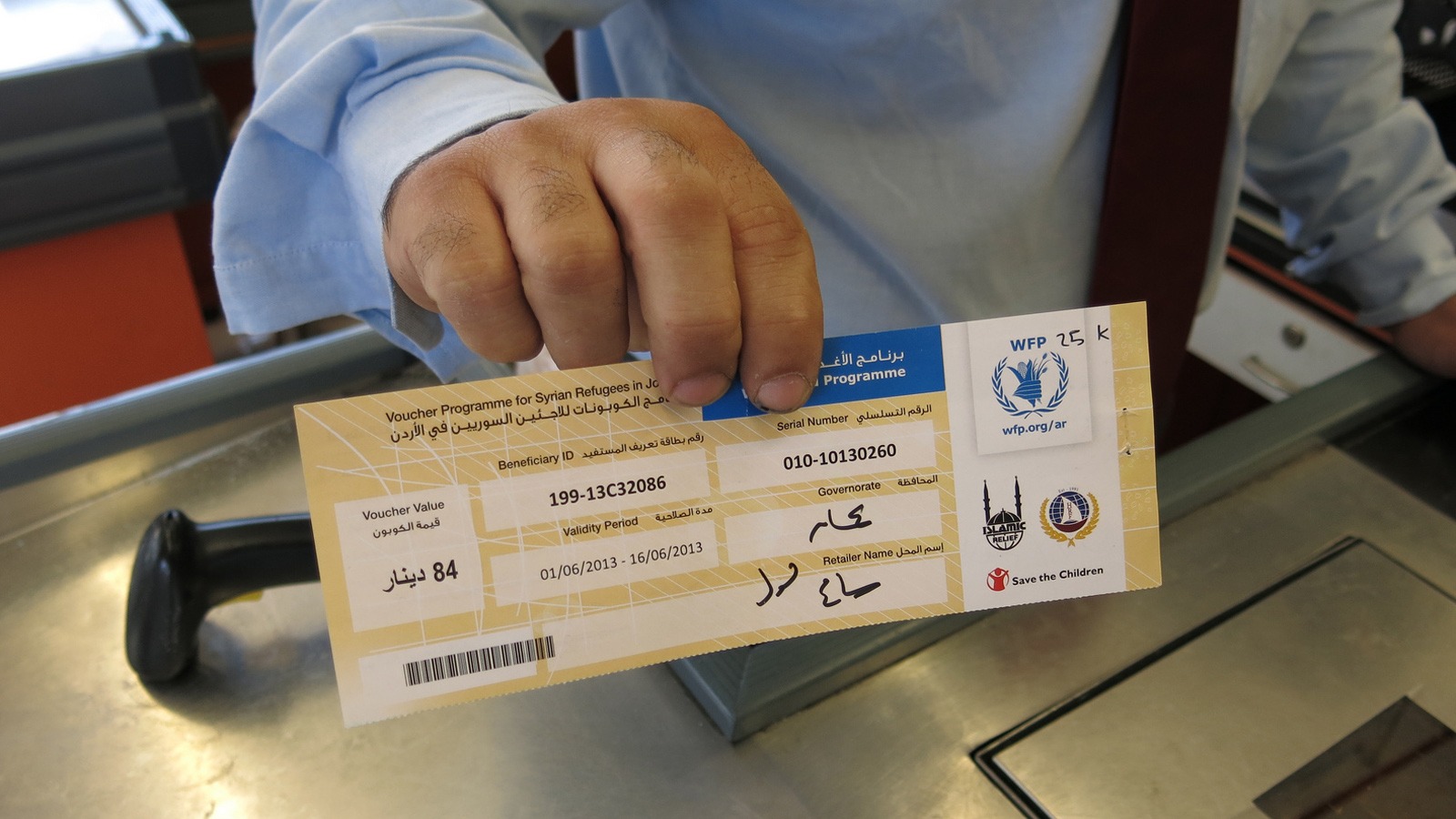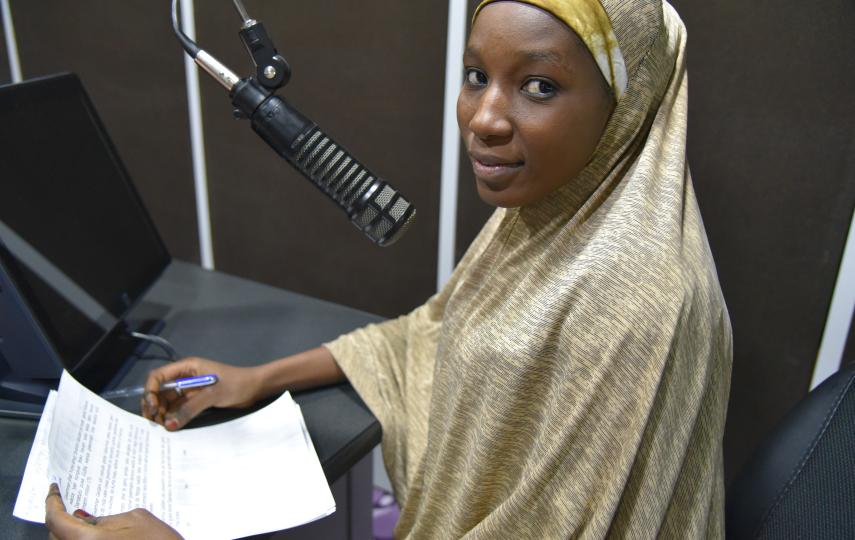Five years ago, delivering food aid was all about hauling cargoes of wheat, rice and maize around the world. Today, instead of queuing for rations, recipients are quite likely to be given the means to buy their own food. As the cash transfer sector matures, IRIN spoke to experts to discuss the latest innovations and lessons learned.
One third of all World Food Programme (WFP) food assistance is now given in the form of cash or vouchers, but cash transfers go beyond food. The current refugee operation in the Middle East is a test bed for cash assistance, for food but also for winter heating payments, help with rent and all kinds of other needs. And the beneficiaries are just as likely to get their money loaded electronically onto various kinds of plastic cards. In Turkey, Jordan and Lebanon, like other upper or middle income countries, there has been a move in recent years away from physical cash and towards different kinds of cashless, electronic payment. The world of humanitarian assistance has to keep up.
The current dynamism of the cash assistance sector has been made visible by a new online tool from the Cash Learning Partnership (CaLP), a “Cash Atlas”, which was presented to the Humanitarian Innovation Conference at Oxford University earlier this month. So far they have logged 514 projects with more than 18 million beneficiaries.
A series of filters allow the data to be shown by donor, by sector, by implementing organization, by means of delivery and so on. They show that food security is by far the biggest sector, the European Union (EU) and the UK Department for International Development (DFID) the most enthusiastic donors, and Oxfam, World Vision, Action Against Hunger and the Red Cross the biggest implementing partners. East Africa is the region where there are the most beneficiaries.
European donors in particular have embraced the change from in-kind food to cash wholeheartedly. “We no long measure food aid contributions in wheat/tons equivalent,” said EU aid body ECHO's Julia Stewart-David, “which was all about the idea of getting rid of agricultural surpluses. Our presumption now is rather, 'Explain to us why you can't do cash'.”
Annalisa Conte, deputy director of policy in WFP's Programme and Innnovation Division, told IRIN the switch to cash had been dramatic. “In 2009 WFP's programme of working in cash or vouchers was around US$10 million, less than 1 percent of our assistance. So from 2009 until now, from $10 million we are at $3 billion. So it's a very short time and a very sharp increase.”
There obviously are still places where you can't send cash. Two of WFP's three biggest emergency operations at the moment (South Sudan and the Central African Republic) still involve trucking in physical food to relieve serious shortages. But the beneficiaries of the third largest programme - refugees in Jordan, Lebanon and Turkey - are living in countries with all the attributes of a functioning modern state - banks, cash machines and supermarkets, and the ability to import food as needed to meet demand. These refugees get vouchers which can be spent in normal shops, and exchanged for any food item apart from sweets and fizzy drinks.
A review of ten years of cash transfer programming by CaLP reveals that the bulk of cash transfer programming (CTP) remains at a small-scale, the biggest barriers to scale-up being its acceptance, institutionalization and implementation across the humanitarian community. To scale up CTP meaningfully, agencies will have to change the way they go about everything from assessments to human resources, notes the review.
Scams and exclusion
“There are now a bewildering range of ways to send money - by cheque or bank transfer, smart cards or prepaid cards, paper or electronic vouchers, or even as good, old-fashioned cash. Despite all the exciting new possibilities, 7 million of the 18.5 million people who received transfers recorded by Cash Atlas still got their money the old-fashioned way. East Africa is the region which has led the world in phone-based “mobile money” systems, and it is also the region making most use of phone transfers, with Oxfam, the International Committee of the Red Cross and Concern all using phones to get help to their beneficiaries.
Christopher Foster of Oxford University's Internet Institute has been doing a study of how mobile phone transfers have been working in Kenya. He reiterated the now well-understood advantages: It is cheap, because it uses the already existing network of mobile phone agents; it is easy to reach scattered recipients over a wide area, as long as they have mobile phone coverage; and most of the recipients find it convenient and more dignified than coming to a central distribution point to get assistance. Organizations running the programmes no longer have to handle large amounts of cash, and it avoids the situation where people leave a central distribution point carrying sums of money, becoming a magnet for thieves.”
Even so, it is not totally secure, says Foster. “There's always this idea that if you use mobile transfers that there's no problem of security - it's all gone. But that's not necessarily the case. In one of the cases I've looked at, one of the problems they've had is that a lot of people gave the wrong numbers, so the money got sent to the wrong people. Also some recipients, especially more vulnerable people, had problems with scams; they got messages saying they had won the lottery, or telling them to send something to this, and they ended up sending the money on.”
Foster also worries about the more vulnerable in general. “In terms of exclusion, there are still some elderly or disabled people who can't make it to an agent, and also people like immigrants, or anyone undocumented, because these systems all require some recent form of documentation. In one of the trials, up to 26 percent of the recipients had to use nominees, other people, to collect the money for them because they couldn't access the service.” The risk is that, while phone transfers are cheap and convenient for the implementing agencies, they could just shift the costs and risks further down the chain, onto people less able to bear them.
One voucher, one card?
Mobile phone transfers are appropriate for rural Kenya, where conventional banks are thin on the ground. But the many agencies serving refugees in Jordan have a range of potential partners in the banking and retail sectors. Researchers from Britain's Overseas Development Institute who looked at these partnerships ended up making a strong plea for rationalization.
“Some banks require extensive documentation from cash recipients; others receive none... Some cash cards are one-off (e.g. for winterization or the start of the school year), while others can be topped up. Some involve cards and PIN codes, while others are based on retinal scans. Some can be used to take out cash, while others can only be used in particular shops.” This, they say, “will create confusion among the refugees, who may not be able to keep track of multiple different cash cards, PIN codes and electronic vouchers, while also creating greater opportunities for abuse.”
It would make sense if all the agencies could all use the same system. The June CTP review recommended improving coordination on cash transfers by agreeing a place - an agency or network - to coordinate cash transfers in the humanitarian architecture.
But as ECHO's Julia Stewart-David told IRIN, adopting one CTP system would have far-reaching implications for the way aid is delivered. The question is: is the humanitarian sector ready?
“The logical implication”, she says, “if you look at more cash-transfer programming, is that you have less specialist need to have 'x' or 'y' product-based assistance delivered. So why would you need as many actors as you have, if you can put it all on one card? Of course, you need people who are specialists in WASH [water sanitation and hygiene], or specialists in food assistance or health to do other parts of the assistance framework or the guidelines or the advocacy. But the actual delivery - you wouldn't need UNHCR [UN Refugee Agency] to do one bit and WFP to do another bit. It could all be done on one voucher, one card.”
eb/aj/cb
This article was produced by IRIN News while it was part of the United Nations Office for the Coordination of Humanitarian Affairs. Please send queries on copyright or liability to the UN. For more information: https://shop.un.org/rights-permissions





